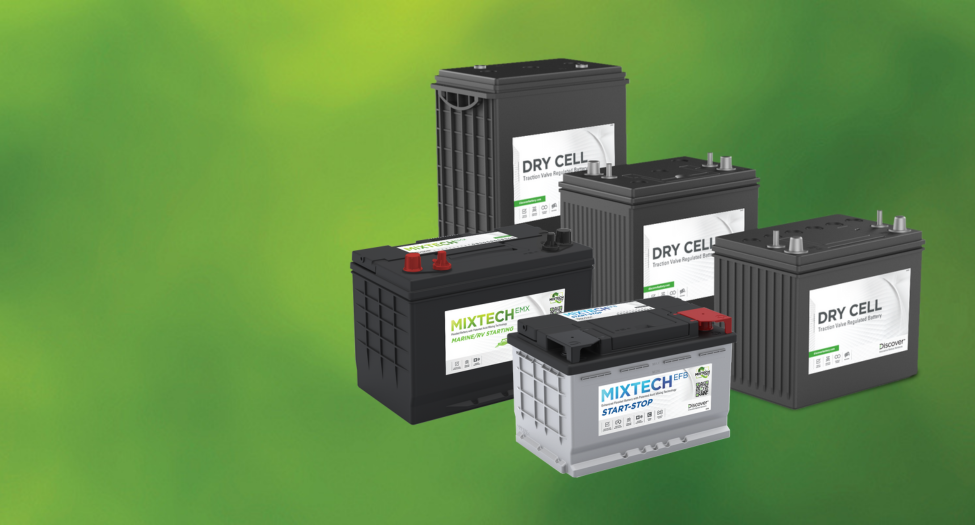Batteries power virtually everything in our modern world, from vehicles and equipment to backup power systems. Optimizing their performance isn't just about convenience - it directly impacts product lifespan, reliability, and your bottom line.
This guide can help you maximize battery life and performance.
Selecting the Right Battery
The foundation of battery optimization begins with choosing the correct battery type for your specific application. Whether you need solutions for transportation (automotive, marine, RV, commercial trucks), motive power applications (mobile elevating work platforms, floor care, material handling), or energy storage systems (solar and backup power), selecting a battery specifically designed for its intended use ensures optimal performance from the start.
As an example, our MIXTECH automotive batteries provide robust starting power, while our DRY CELL AGM batteries excel in deep-cycle applications.
Mastering Charging Techniques
Proper charging is perhaps the most critical factor in extending battery life. Be sure to choose a charger that is compatible with your battery type/chemistry and follow manufacturer guidelines for current and voltage settings. Implementing temperature compensation prevents over/undercharging in extreme conditions.
For flooded batteries, ensure good ventilation during charging and always avoid sparks near any battery. Never charge a frozen battery; allow it to thaw completely first, and avoid charging at high temperatures (above 50°C/125°F).
Both overcharging and undercharging significantly reduce battery lifespan, so finding the right balance is essential.
Managing Depth of Discharge (DoD)
The percentage of a battery's capacity used before recharging dramatically impacts its overall lifespan. Limiting discharge to 40-50% DoD is generally optimal for maximizing cycle life.
Shallow discharges enable more charge-discharge cycles over a battery's lifetime. Consider this practical example: a battery consistently discharged to only 50% capacity will last considerably longer than one regularly drained to 80-100%.
By carefully managing the depth of discharge, you can significantly extend the useful life of your batteries. In lead-acid batteries, overcharging is prevented by the charger or alternator, while the Battery Management System (BMS) serves this purpose in lithium batteries. Undercharging occurs when batteries are not plugged into a charger and remain unused for a long period of time.
Temperature Considerations
Temperature affects both battery performance and longevity in several important ways. Cooler temperatures during operation and storage generally extend battery life, while higher temperatures accelerate internal chemical reactions and self-discharge rates.
Proper storage temperatures vary by battery type (AGM, GEL, SLI/Flooded), but as a general rule, store batteries fully charged, ideally connected to a smart charger during periods of inactivity.
Remember that self-discharge rates increase significantly with temperature - a battery will lose its charge much faster at 40°C than at 8°C, even when not in use.
Essential Maintenance Practices
Regular maintenance ensures optimal performance and longevity throughout your battery's life. Check and recharge batteries at least every three weeks, even when not in use.
For flooded lead-acid batteries, be aware of acid stratification (though this doesn't apply to maintenance-free AGM and GEL batteries). Minimize extended use of electrical loads when the engine or charging system is off to prevent excessive discharge.
For reduced upkeep requirements, consider maintenance-free options like our DRY CELL AGM batteries, which are engineered for long-term reliability with minimal intervention.
Understanding Cycle Life
When evaluating batteries, understanding cycle life testing standards provides valuable context for making informed decisions. International standards such as IEC 254-1, IEC 60896-11, and J2185 set guidelines for testing performance under different conditions.
Cycle life comparisons should consider testing parameters including temperature, charging/discharging currents, depth of discharge, and end-of-life definitions. A battery advertised with a longer cycle life under less stringent conditions may not outperform one with a shorter cycle life tested under more demanding standards. Always look beyond the numbers to understand the testing methodology behind cycle life claims.
Key Takeaways
What to remember? These six principles will help you get the most value and performance from your battery investment:
- Choose wisely: Select a battery specifically designed for your application
- Charge properly: Use the correct charger and settings for your battery chemistry
- Limit discharge: Aim for 40-50% DoD to maximize cycle life
- Manage temperature: Keep batteries cool during operation and storage when possible
- Maintain regularly: Implement consistent charging schedules and proper maintenance
- Understand specifications: Look beyond cycle life numbers to the testing conditions behind them
By implementing these strategies, you'll not only extend the life of your batteries but also reduce operating costs and environmental impact.






